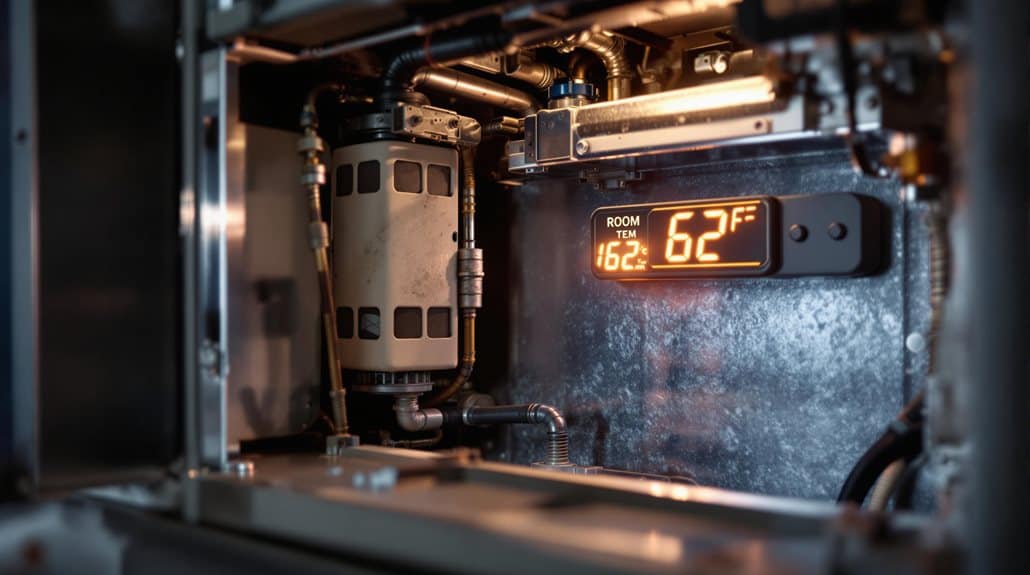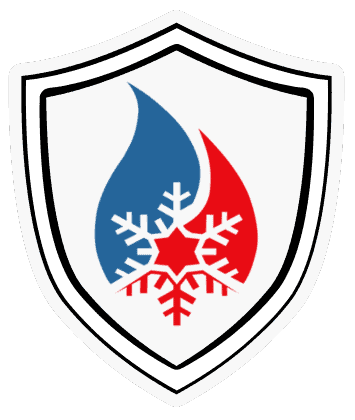When your furnace isn’t blowing hot air, start by checking the air filter. Regular filter cleaning or replacement prevents issues and saves time in the long run. Ensure your thermostat has fresh batteries and is functioning correctly.
If the problem persists, clean the dirty flame sensor, as a faulty sensor often causes heating issues. Be patient, as some furnaces need a few minutes to warm up. However, if you’re still getting cold air after 5 minutes, look into potential ignition system troubles or other internal issues. For peace of mind and a stress-free home, prioritize furnace maintenance to catch issues early and avoid chilly surprises.
Common Reasons for a Furnace Not Blowing Hot Air
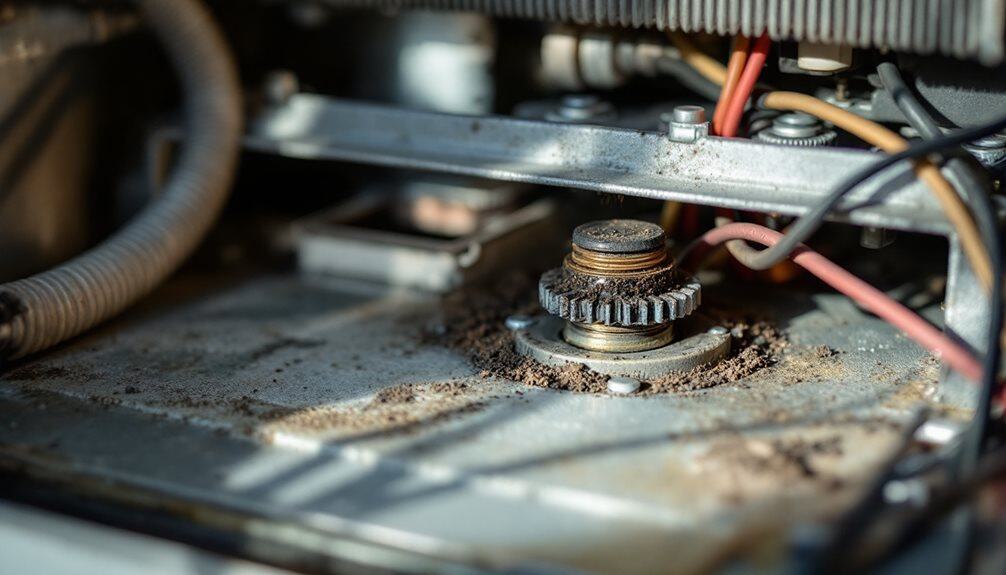
Let’s start by looking at some of the most common reasons your furnace isn’t giving you the warm air you deserve.
From simple problems like incorrect thermostat settings and dirty filters to more complex issues like pilot light failures and high limit switch problems, we’ll help you understand what might be happening in your home.
Regular checks, such as ensuring the furnace pilot light is lit with a steady blue flame, are crucial to prevent heating issues and ensure reliable operation.
Thermostat Issues
Your thermostat is like the brain of your heating system, telling your furnace when to turn on and off. When it’s not working correctly, your whole system gets confused. We often find that thermostats need recalibration because they’re reading temperatures incorrectly. It’s like when your phone says it’s sunny outside, but you look out the window and see rain! Sometimes, the fix is as simple as changing the batteries or cleaning dust from the sensors. In other cases, thermostat replacement might be necessary, especially if you’re dealing with an older model that’s seen better days.
Clogged/Dirty Air Filter
Think of it like trying to breathe through a stuffy nose – your furnace needs clean, clear airways to function properly. When dust and debris build up in the filter, it creates significant airflow issues that affect all furnace types.
Regular cleaning improves furnace efficiency and reduces energy costs, ensuring optimal performance and extending the appliance’s lifespan.
We see this problem frequently in homes across Vaughan and the GTA. Your furnace has to work much harder when the filter is clogged, which not only reduces heating efficiency but can lead to system strain and higher energy bills.
The good news? This is one of the easiest furnace problems to fix.
At ALP Heating, we recommend checking your filter monthly and replacing it every 1-3 months, depending on usage.
We’re always here to help with professional maintenance if you’re unsure about proper filter replacement for your specific system.
Furnace Needs Time to Heat Up
A common misconception about furnaces is that they should instantly produce hot air when turned on. In reality, your furnace needs a few minutes to properly heat up before delivering warm air throughout your home.
Think of it like warming up your car on a cold winter morning – it takes time to reach peak performance.
For the best heating system efficiency, we recommend waiting 3-5 minutes after startup before expecting warm air from your vents. During this time, your furnace goes through several important stages: the ignition sequence starts, the heat exchanger warms up, and the blower motor begins circulating air. This waiting period ensures proper thermostat function and helps avoid short cycling issues, which can lead to increased wear and tear on the furnace system.
These furnace operation tips will help you get the most comfort from your system.
If you’re still feeling cold air after 5-7 minutes, there might be an underlying issue that needs attention.
High Limit Switch Failure
While proper startup time is important for furnace operation, a high limit switch failure can prevent your system from producing any heat at all.
Think of the high limit switch as your furnace’s safety guard – it’s there to shut things down if temperatures get too high. When this switch malfunctions, your furnace won’t work properly, even if everything else is fine.
At ALP Heating, we often find that dirty air filters are the main culprit behind high limit switch problems. A clogged filter restricts airflow, causing your furnace to overheat. It’s like trying to breathe through a thick blanket – not very effective, right?
These safety mechanisms are vital, but they can be frustrating when they’re not working correctly. Regular maintenance, such as inspecting air filters, can help prevent high limit switch issues and ensure your furnace operates efficiently.
If you’re experiencing issues with your high limit switch, don’t wait until it’s freezing to call us. Our TSSA-licensed technicians can quickly diagnose and fix the problem, ensuring your furnace runs safely and efficiently, and we’re just a phone call away at (647) 972-8714
Remember, regular maintenance can prevent these issues from happening in the first place.
Pilot Light Out/Ignition Issues
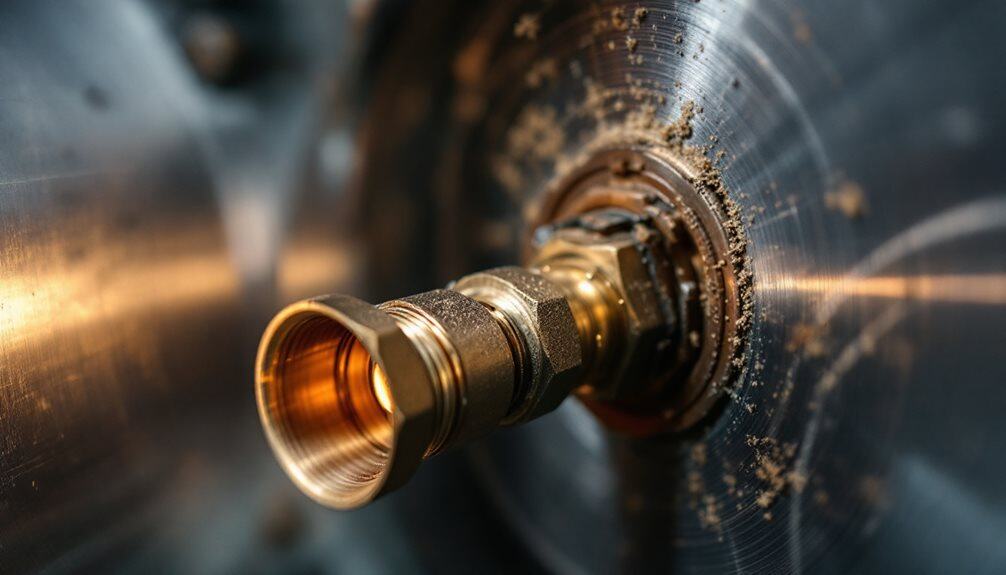
When your furnace isn’t producing heat, a faulty pilot light or ignition system often bears the blame. We find that pilot light troubleshooting is one of the most common service calls we receive at ALP Heating, especially during those first cold snaps of winter. If you have an older furnace with a standing pilot light, it may simply be blown out. In newer systems, electronic ignition failures can prevent your furnace from starting up properly. Don’t worry – these issues are usually straightforward to diagnose and fix. You might notice clicking sounds as your furnace tries to light, or perhaps there’s no sound at all. Sometimes it’s just a dirty flame sensor or pilot orifice causing the problem.
Dirty Flame Sensor
Related to ignition problems, dirty flame sensors rank among the most frequent furnace issues we encounter at ALP Heating. Your flame sensor acts like a safety guard, making sure gas only flows when there’s an actual flame. When it gets covered in dirt, rust, or soot, it can’t do its job properly. You might notice your furnace trying to start but shutting off after just a few seconds – that’s often a telltale sign of a dirty flame sensor. While flame sensor cleaning is something we handle regularly, it’s not a DIY project we’d recommend. One wrong move could damage this sensitive component. Our TSSA-licensed technicians use specialized tools and techniques to clean these sensors properly. If you’re experiencing these symptoms, don’t wait until your furnace completely fails. We can typically clean your flame sensor during a routine maintenance visit. And here’s a helpful sensor replacement tip: even with regular cleaning, flame sensors usually need replacement every 5-7 years.
Loose Ductwork Joints
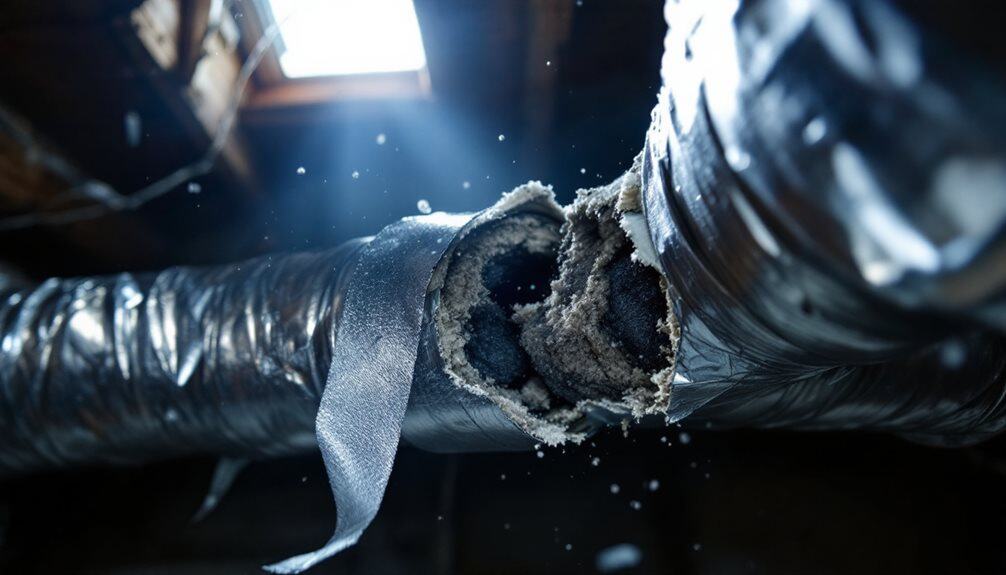
Loose ductwork joints represent a common but often overlooked cause of heating inefficiency. When your ducts aren’t properly sealed, you’re literally letting your warm air escape into unused spaces like crawl spaces and attics.
| Signs of Loose Ductwork | What You Can Do |
|---|---|
| Whistling sounds | Schedule professional duct sealing |
| Higher energy bills | Have joints inspected and sealed |
| Rooms heating unevenly | Get a thorough duct assessment |
| Visible gaps in ductwork | Request immediate repair service |
| Dusty home conditions | Book regular maintenance checks |
These gaps create airflow obstruction issues that make your furnace work harder than necessary. Think of it like trying to drink from a straw with holes in it – pretty inefficient, right? Unsealed ducts can lose up to 20% of heated air, leading to increased heating costs; sealing ducts enhances efficiency.
Incorrectly Sized Furnace
An incorrectly sized furnace can greatly impact your home’s comfort and energy efficiency. When your furnace is too large or too small for your space, it won’t heat your home properly and could lead to increased energy bills.
Think of it like wearing shoes that don’t fit – they’ll either pinch your toes or slip right off!
At ALP Heating, we’ve seen many homes with improper furnace sizing issues. A furnace that’s too small will struggle to reach your desired temperature, running constantly and wearing itself out.
On the flip side, an oversized unit will heat too quickly, leading to frequent on-off cycling that wastes energy and causes uneven heating.
Getting the right heating capacity isn’t just about square footage – it involves calculating factors like ceiling height, insulation levels, and window placement. Efficiency and cost-effectiveness are also important considerations when selecting the right furnace type to ensure optimal performance and energy savings.
Overheating Furnace
While proper furnace sizing helps prevent many issues, furnace overheating can occur in any unit and poses serious safety concerns. Common furnace overheating symptoms include a burning smell, unusual noises, and your system frequently shutting down. Don’t ignore these warning signs – they’re your furnace’s way of crying for help!
When it comes to furnace safety measures, regular maintenance is your best defense against overheating. We often find that dirty filters, blocked vents, or malfunctioning limit switches are the culprits. These problems restrict airflow and force your furnace to work harder than necessary. Think of it like running with a stuffy nose – it’s just not efficient!
Regular Maintenance
Just as your car needs regular tune-ups, your furnace requires consistent professional maintenance to operate safely and efficiently. At ALP Heating, we recommend scheduling furnace upkeep at least once a year, preferably before the winter season hits. This simple step can prevent costly breakdowns when you need your heating system most.
Our TSSA-licensed technicians serve Vaughan and the Greater Toronto Area, providing thorough inspections and tune-ups that’ll keep your system purring like a kitten. Remember, a well-maintained furnace isn’t just about comfort – it’s about safety, efficiency, and saving money on your energy bills.
Conclusion
While a cold furnace can turn your cozy home into an igloo, you don’t have to suffer through chilly nights. We’re here to help, whether it’s a quick DIY fix or time for professional care. From simple thermostat checks to complete system diagnostics, our TSSA-licensed team at ALP Heating is just a call away.



